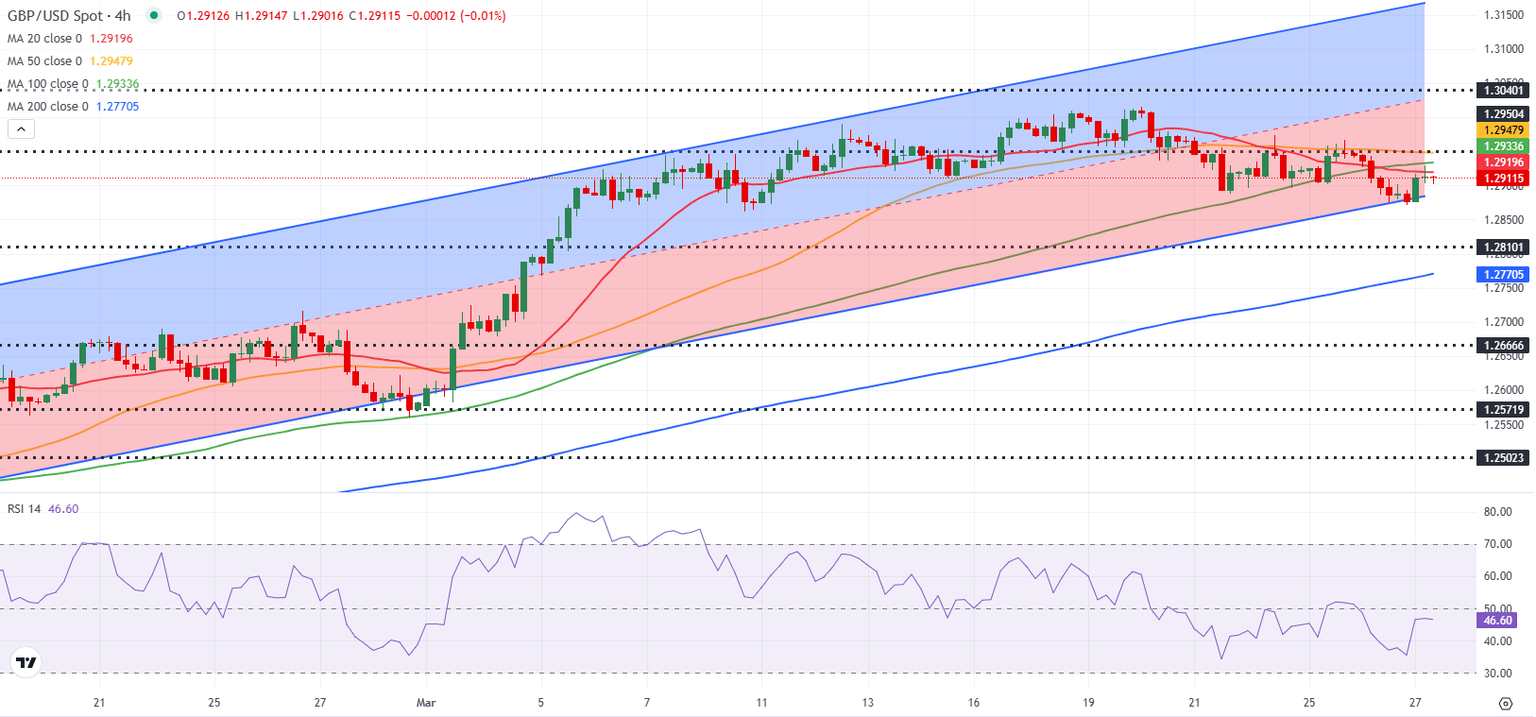GBP/USD Forecast: Pound Sterling remains fragile despite recent rebound
- GBP/USD clings to marginal daily gains above 1.2900 in the European morning.
- Downward revision to UK growth forecast and soft inflation data weighed on Pound Sterling.
- US economic calendar will feature weekly Initial Jobless Claims data.

Following a two-day recovery, GBP/USD turned south and lost about 0.5% on Wednesday. After dipping below 1.2900, the pair managed to correct higher early Thursday.
British Pound PRICE This week
The table below shows the percentage change of British Pound (GBP) against listed major currencies this week. British Pound was the weakest against the Canadian Dollar.
| USD | EUR | GBP | JPY | CAD | AUD | NZD | CHF | |
|---|---|---|---|---|---|---|---|---|
| USD | 0.53% | 0.05% | 0.83% | -0.40% | -0.51% | -0.12% | 0.11% | |
| EUR | -0.53% | -0.58% | -0.23% | -0.89% | -1.05% | -0.60% | -0.38% | |
| GBP | -0.05% | 0.58% | 0.78% | -0.93% | -0.50% | -0.01% | 0.10% | |
| JPY | -0.83% | 0.23% | -0.78% | -1.21% | -1.34% | -0.92% | -0.72% | |
| CAD | 0.40% | 0.89% | 0.93% | 1.21% | -0.05% | 0.28% | 0.51% | |
| AUD | 0.51% | 1.05% | 0.50% | 1.34% | 0.05% | 0.47% | 0.69% | |
| NZD | 0.12% | 0.60% | 0.01% | 0.92% | -0.28% | -0.47% | 0.29% | |
| CHF | -0.11% | 0.38% | -0.10% | 0.72% | -0.51% | -0.69% | -0.29% |
The heat map shows percentage changes of major currencies against each other. The base currency is picked from the left column, while the quote currency is picked from the top row. For example, if you pick the British Pound from the left column and move along the horizontal line to the US Dollar, the percentage change displayed in the box will represent GBP (base)/USD (quote).
Softer-than-expected inflation data weighed on Pound Sterling in the early European session on Wednesday. Later in the day, the UK's Office for Budget Responsibility announced that they revised down the Gross Domestic Product (GDP) growth forecast for 2025 to 1%, causing GBP/USD to stretch lower.
While presenting the Spring Budget, British finance minister Rachel Reeves noted that the global economy has become more uncertain and announced reductions to spending plans.
On Thursday, the US Department of Labor will publish the weekly Initial Jobless Claims data. Markets expect the number of first-time applications for unemployment benefits to rise to 225,000 from 223,000. A noticeable decline in this data could support the USD and force GBP/USD to turn south.
Meanwhile, markets adopt a cautious stance early Thursday following the latest remarks from US President Donald Trump on tariffs.
US President Donald Trump announced on Wednesday that they are planning to impose a 25% tariff on all car imports to the US. Trump further noted that auto tariffs will be permanent and go into effect on April 2. When asked whether the UK would impose retaliatory tariffs against the US, "We are not at the moment in a position where we want to do anything to escalate these trade wars," Reeves responded.
In case safe-haven flows dominate the action in financial markets in the second half of the day, GBP/USD could have a hard time holding its ground.
GBP/USD Technical Analysis

The Relative Strength Index (RSI) indicator on the 4-hour chart stays slightly below 50 despite the latest rebound, highlighting a lack of bullish momentum.
On the downside, 1.2900-1.2890, where the lower limit of the ascending regression channel and the 20-day Simple Moving Average (SMA) are located, aligns as a key support level before 1.2800 (200-day SMA). Looking north, resistance could be seen at 1.2940-1.2950 (50-period SMA, static level), 1.3000 (static level, round level) and 1.3030 (mid-point of the ascending channel).
Pound Sterling FAQs
The Pound Sterling (GBP) is the oldest currency in the world (886 AD) and the official currency of the United Kingdom. It is the fourth most traded unit for foreign exchange (FX) in the world, accounting for 12% of all transactions, averaging $630 billion a day, according to 2022 data. Its key trading pairs are GBP/USD, also known as ‘Cable’, which accounts for 11% of FX, GBP/JPY, or the ‘Dragon’ as it is known by traders (3%), and EUR/GBP (2%). The Pound Sterling is issued by the Bank of England (BoE).
The single most important factor influencing the value of the Pound Sterling is monetary policy decided by the Bank of England. The BoE bases its decisions on whether it has achieved its primary goal of “price stability” – a steady inflation rate of around 2%. Its primary tool for achieving this is the adjustment of interest rates. When inflation is too high, the BoE will try to rein it in by raising interest rates, making it more expensive for people and businesses to access credit. This is generally positive for GBP, as higher interest rates make the UK a more attractive place for global investors to park their money. When inflation falls too low it is a sign economic growth is slowing. In this scenario, the BoE will consider lowering interest rates to cheapen credit so businesses will borrow more to invest in growth-generating projects.
Data releases gauge the health of the economy and can impact the value of the Pound Sterling. Indicators such as GDP, Manufacturing and Services PMIs, and employment can all influence the direction of the GBP. A strong economy is good for Sterling. Not only does it attract more foreign investment but it may encourage the BoE to put up interest rates, which will directly strengthen GBP. Otherwise, if economic data is weak, the Pound Sterling is likely to fall.
Another significant data release for the Pound Sterling is the Trade Balance. This indicator measures the difference between what a country earns from its exports and what it spends on imports over a given period. If a country produces highly sought-after exports, its currency will benefit purely from the extra demand created from foreign buyers seeking to purchase these goods. Therefore, a positive net Trade Balance strengthens a currency and vice versa for a negative balance.
Premium
You have reached your limit of 3 free articles for this month.
Start your subscription and get access to all our original articles.
Author

Eren Sengezer
FXStreet
As an economist at heart, Eren Sengezer specializes in the assessment of the short-term and long-term impacts of macroeconomic data, central bank policies and political developments on financial assets.

















